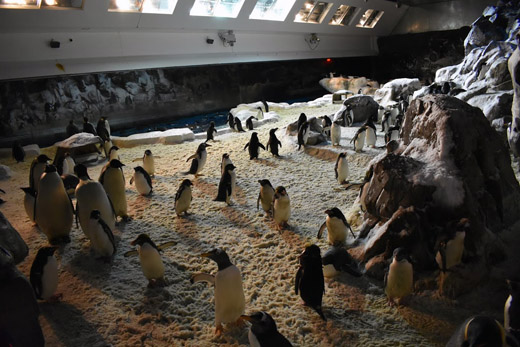
Story by Donald H. Harrison; Photos by Shor M. Masori


SAN DIEGO – If I had gone into the place blind-folded, I might have thought I was in the sanctuary of a synagogue—a very cold sanctuary—listening to the sounds of shofars being blown in celebration of Rosh Hashanah.
The blasts were reminiscent of the tekiah call of the shofar, and one mighty one even sounded like tekiah godol. The temperature in the room made me reflect back to the time that I had served my congregation as religious affairs vice president, which on Saturdays consisted mainly of handing out Torah blessing honors, and trying to find a balance between those congregants who thought the sanctuary too hot and those who thought it too cold. In this instance, I definitely would have agreed with those who thought it too cold. It was 25 degrees Fahrenheit.
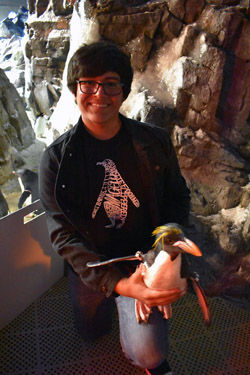
The occasion wasn’t a Jewish holiday, but rather it was a secular celebration. April 25th was World Penguin Day, the day when penguins in Antarctica typically begin migrating towards the northern part of the continent. To mark the occasion, photographer and grandson Shor M. Masori and I took a “Behind the Scenes” tour of the Penguin Encounter at SeaWorld. Shor’s classmate, Fausto Baltazar, for whom penguins are a major interest, joined us – his penguin-themed T-shirt attracting several favorable comments from SeaWorld staff members Booker Crenshaw Jr. of the marketing department and Paige Silva, an aviculturist. What the penguins thought of it, I couldn’t tell, but the way one of the penguins nestled onto Baltazar’s lap, surely it didn’t disapprove.
Those shofar-like blasts were the “trumpet” calls of the Emperor Penguins, largest of the penguin family.
To begin our tour, we stepped in a tray filled with solution to prevent our shoes from tracking in contaminants. We were next met in the kitchen area of the Penguin Encounter by aviculturist Silva, who dimmed the lights in the room, and then brought out a Macaroni Penguin, so-named because it has on its head yellow feathers that somewhat resemble the pasta favorite.
This particular Macaroni didn’t have a nickname yet, but seemed to respond well to its breed and number, Macaroni 221, whenever that name was cooed by Silva, an eight-year employee of SeaWorld, with the last two years in specialization at the Penguin Encounter. “A lot of the birds get nicknames—this one doesn’t yet, but you will see several upstairs [in the exhibit area], for example, Stephen, Princess, and Vlad,” she commented. “Princess, an Emperor Penguin, was so named because she has a regal air about her. Stephen, a King Penguin, was named for the author Stephen King. As for Vlad, Silva said, “He is a bird that came here as part of SSP—Species Survival Plan. They want to make sure that all the genetics aren’t bottlenecked in one location. Vlad came here from Cincinnati and he had a different name when he came. But we noticed that he had a behavior that was very stabby, and he has a long beak. So, he was named after Vlad the Impaler,” the 15th Century Romanian prince who used to dispatch his opponents by impaling them. “To be honest,” Silva hastened to add, “he is a super sweet bird, but it’s like he walks around with a little sword.”
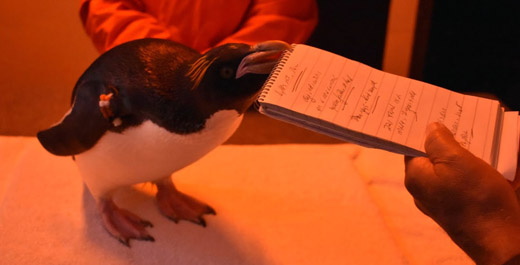
If I were naming Macaroni 221, I might call him “news hound” or perhaps “news critic,” because while I was interviewing Silva, and not paying strict attention to 221, he waddled across a kitchen counter and tried to take a bite out of my reporter’s notebook. Silva said penguins are naturally curious animals, and that they love to play games and have fun. Probably Macaroni 221 was attracted to the spiral rings on the notebook, as penguins like shiny objects.
I wondered if penguins minded the constant stream of visitors who ride along a motorized sidewalk along the glass viewing area of the Penguin Encounter.
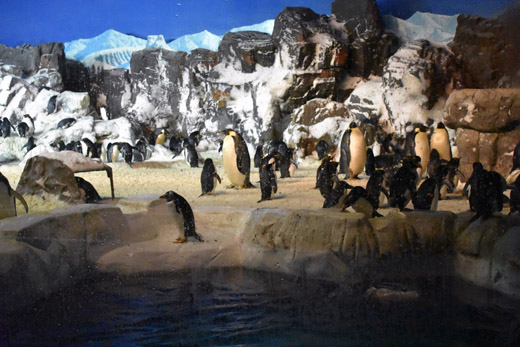
“I think it is white noise to them,” Silva replied. “It doesn’t bother them. If anything, it can be a type of enrichment for them. When we walk out along the glass, and I kneel down to the water level [where the penguins swim], the Gentoo girl [one of her favorite penguins among the 400 that populate the Encounter] and a bunch of others come right over, and it’s a game, enriching, different, and exciting for them.”
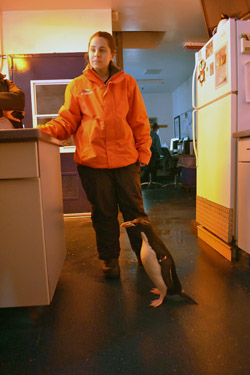
“Penguins are very easy to entertain,” she added. “The fresh snow that we provide everyday is like Christmas for them. When you are blowing snow in there, they get all excited and they do snow angels, and they are tobogganing, and sometimes we give them a hill to climb over. On another occasion we gave them tunnels by putting snow over buckets, and after the snow freezes, pulling the buckets out, creating a frozen igloo, and they go running in and out of it. We have made slides into the water, and even if you throw chunks of ice with krill and other types of fish, it is enriching for them to play with in the water. We’ve given them a tennis ball and they chase it around as if it were an egg that they can try to steal from each other.”
Machines like those that make snow cones, but on a far more giant scale, provide 400 tons of snow each day that is blown into the Penguin Encounter through a lengthy, fat hose than can be extended through the exhibit. Between 700 and 1,000 pounds of fish are provided daily to the collection of 400 penguins, through three methods of feeding. Some penguins accept fish given to them by hand. Others prefer to scoop it out of feeding stations that look like little huts. Others prefer to catch the fish in the water. SeaWorld makes it a point to keep enough fish on site so that none of the penguins go hungry.
Prior to the breeding season. penguins will eat more fish in anticipation of the fact that while they are hatching eggs, they won’t be able to move much from the nest. Being so stationary, the penguins survive off the fat stored in their bodies.
Silva said the Penguin Encounter is darkened, as was the kitchen where we entered, because SeaWorld carefully simulates the light conditions of Antarctica and the Southern Hemisphere. Being that the seasons of the Southern Hemisphere are reverse of those in the Northern Hemisphere, winter is approaching back in Antarctica, even as summer is approaching here.
From the back side of the exhibit, one can see a lot of lights on the ceiling. “We are gradually dimming those lights so that every day they get lower and lower, and eventually it will become dark 24 hours a day,” Silva said. “We even simulate a sunrise and a sunset. Tonight about 5:30 p.m., I will go and change the lights, and that will signal to the birds that the sun is going down. At night, the lights go out, and then in the morning we simulate a sunrise. As daylight gets shorter in the Southern Hemisphere, the period of light here will also get shorter.”
Silva said every penguin is banded with a number code that corresponds to a numbered computer file, so that such information as the penguin’s date of birth, parentage, current weight, and medical history is easily accessible. As the differences between male and female penguins do not meet the eye, the files also include the penguin’s gender. “Generally, we get that information from blood samples; either when the blood is drawn and tested, or if they have hatched here, you can take their egg shell and you can extract DNA.”
She said she thinks Macaroni 221 may be male, but that she tends to personify all of them as females. “The beak is pretty,” she explained. Macaroni 221 is just two years old. “The Macaronis really like to explore things,” she said.
Penguins are soft to the touch, possibly because of the density of their feathers. “They have 70 to 100 feathers per square inch, so they are extremely well insulated for their environment,” Silva said. “It’s like wearing a wet suit. They are the densest birds, in terms of feathers. A chicken, for example, has only 12 to 15 feathers per square inch.”
Birds like gulls and sparrows have relatively hollow bones, because “they want to be very light to be able to take flight,” said Silva. Heavier-boned penguins are divers, and “they are depending on that weight to help take them down into the ocean.”
Silva said World Penguin Day, April 25th, is useful for explaining to people that it’s important to protect the oceans from pollution and global warming. Penguins are an “indicator species for the ocean,” she said. “Their ovulations, their breeding sites, their access to food – all are parts of knowing what is going on in the ocean.”
Having been assigned for two years to the Penguin Encounter, Silva has developed a fondness for a number of the birds. Among others, she likes Macaroni 221, “Princess,” and Gentoo 358, whom she calls “Baby Girl.”
“I can come here and say, ‘Baby Girl’ and she will come running over,” Silva said. “She is only a couple of years old, compared to this lady here, Gentoo 31, who is 34 years old.”
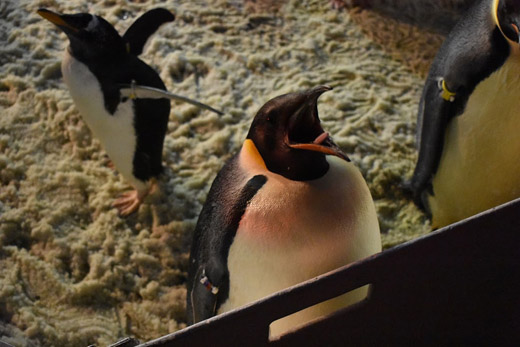
A mark of distinction for SeaWorld are its Emperor Penguins, whose calls are like the sounds of a shofar. “We are the only institution in the Western Hemisphere that has Emperors, so I tell people who take the Behind the Scenes tour to take a deep breath when you are around them because it’s probably a once-in-a-lifetime opportunity. I don’t know of any place except the Antarctic where you can get this close to them. We were originally built as a faculty for scientists to research cold weather penguins, so we are very fortunate.”
Second in size to the Emperors are the Kings, followed by the Gentoos. Smaller penguins in the Encounter include the Macaronis, Chinstraps, and Adelies. The Chinstraps are so named because of a dark band below the white portion of their faces; The Adelies have a white ring around their eyes.
“Emperors are very sweet,” Silva commented. “Princess will fall asleep in your lap, but it is always on her terms.”
*
Harrison is editor and Masori is a staff photographer for San Diego Jewish World. They may be contacted respectively via donald.harrison@sdjewishworld.com and shor.masori@sandiegojewishworld.com